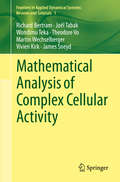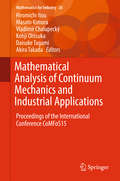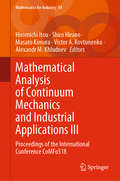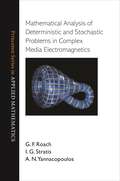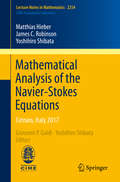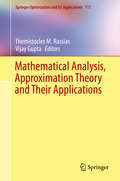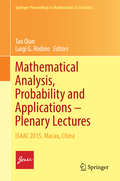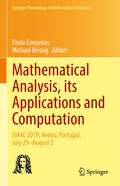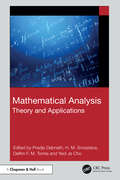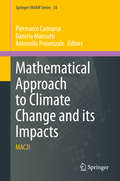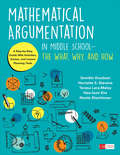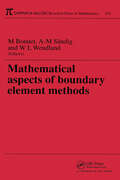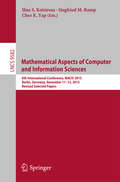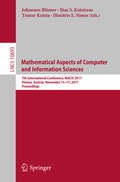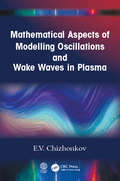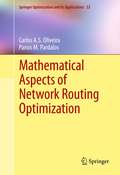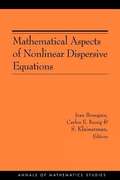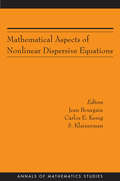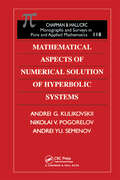- Table View
- List View
Mathematical Analysis in Interdisciplinary Research (Springer Optimization and Its Applications #179)
by Themistocles M. Rassias Ioannis N. Parasidis Efthimios ProvidasThis contributed volume provides an extensive account of research and expository papers in a broad domain of mathematical analysis and its various applications to a multitude of fields. Presenting the state-of-the-art knowledge in a wide range of topics, the book will be useful to graduate students and researchers in theoretical and applicable interdisciplinary research. The focus is on several subjects including: optimal control problems, optimal maintenance of communication networks, optimal emergency evacuation with uncertainty, cooperative and noncooperative partial differential systems, variational inequalities and general equilibrium models, anisotropic elasticity and harmonic functions, nonlinear stochastic differential equations, operator equations, max-product operators of Kantorovich type, perturbations of operators, integral operators, dynamical systems involving maximal monotone operators, the three-body problem, deceptive systems, hyperbolic equations, strongly generalized preinvex functions, Dirichlet characters, probability distribution functions, applied statistics, integral inequalities, generalized convexity, global hyperbolicity of spacetimes, Douglas-Rachford methods, fixed point problems, the general Rodrigues problem, Banach algebras, affine group, Gibbs semigroup, relator spaces, sparse data representation, Meier-Keeler sequential contractions, hybrid contractions, and polynomial equations. Some of the works published within this volume provide as well guidelines for further research and proposals for new directions and open problems.
Mathematical Analysis of Complex Cellular Activity
by Richard Bertram Joël Tabak Wondimu Teka Theodore Vo Martin Wechselberger Vivien Kirk James SneydThis book contains two review articles on mathematical physiology that deal with closely related topics but were written and can be read independently. The first article reviews the basic theory of calcium oscillations (common to almost all cell types), including spatio-temporal behaviors such as waves. The second article uses, and expands on, much of this basic theory to show how the interaction of cytosolic calcium oscillators with membrane ion channels can result in highly complex patterns of electrical spiking. Through these examples one can see clearly how multiple oscillatory processes interact within a cell, and how mathematical methods can be used to understand such interactions better. The two reviews provide excellent examples of how mathematics and physiology can learn from each other, and work jointly towards a better understanding of complex cellular processes. Review 1: Richard Bertram, Joel Tabak, Wondimu Teka, Theodore Vo, Martin Wechselberger: Geometric Singular Perturbation Analysis of Bursting Oscillations in Pituitary Cells Review 2: Vivien Kirk, James Sneyd: Nonlinear Dynamics of Calcium
Mathematical Analysis of Continuum Mechanics and Industrial Applications
by Masato Kimura Hiromichi Itou Vladimír Chalupecký Kohji Ohtsuka Daisuke Tagami Akira TakadaThis book focuses on mathematical theory and numerical simulation related to various aspects of continuum mechanics, such as fracture mechanics, elasticity, plasticity, pattern dynamics, inverse problems, optimal shape design, material design, and disaster estimation related to earthquakes. Because these problems have become more important in engineering and industry, further development of mathematical study of them is required for future applications. Leading researchers with profound knowledge of mathematical analysis from the fields of applied mathematics, physics, seismology, engineering, and industry provide the contents of this book. They help readers to understand that mathematical theory can be applied not only to different types of industry, but also to a broad range of industrial problems including materials, processes, and products.
Mathematical Analysis of Continuum Mechanics and Industrial Applications III: Proceedings of the International Conference CoMFoS18 (Mathematics for Industry #34)
by Masato Kimura Hiromichi Itou Shiro Hirano Victor A. Kovtunenko Alexandr M. KhludnevThis book focuses on mathematical theory and numerical simulation related to various areas of continuum mechanics, such as fracture mechanics, (visco)elasticity, optimal shape design, modelling of earthquakes and Tsunami waves, material structure, interface dynamics and complex systems. Written by leading researchers from the fields of applied mathematics, physics, seismology, engineering, and industry with an extensive knowledge of mathematical analysis, it helps readers understand how mathematical theory can be applied to various phenomena, and conversely, how to formulate actual phenomena as mathematical problems. This book is the sequel to the proceedings of the International Conference of Continuum Mechanics Focusing on Singularities (CoMFoS) 15 and CoMFoS16.
Mathematical Analysis of Deterministic and Stochastic Problems in Complex Media Electromagnetics (Princeton Series in Applied Mathematics #42)
by G. F. Roach I. G. Stratis A. N. YannacopoulosElectromagnetic complex media are artificial materials that affect the propagation of electromagnetic waves in surprising ways not usually seen in nature. Because of their wide range of important applications, these materials have been intensely studied over the past twenty-five years, mainly from the perspectives of physics and engineering. But a body of rigorous mathematical theory has also gradually developed, and this is the first book to present that theory. Designed for researchers and advanced graduate students in applied mathematics, electrical engineering, and physics, this book introduces the electromagnetics of complex media through a systematic, state-of-the-art account of their mathematical theory. The book combines the study of well posedness, homogenization, and controllability of Maxwell equations complemented with constitutive relations describing complex media. The book treats deterministic and stochastic problems both in the frequency and time domains. It also covers computational aspects and scattering problems, among other important topics. Detailed appendices make the book self-contained in terms of mathematical prerequisites, and accessible to engineers and physicists as well as mathematicians.
Mathematical Analysis of Shock Wave Reflection (Series in Contemporary Mathematics #4)
by Shuxing ChenThis book is aimed to make careful analysis to various mathematical problems derived from shock reflection by using the theory of partial differential equations. The occurrence, propagation and reflection of shock waves are important phenomena in fluid dynamics. Comparing the plenty of studies of physical experiments and numerical simulations on this subject, this book makes main efforts to develop the related theory of mathematical analysis, which is rather incomplete so far. The book first introduces some basic knowledge on the system of compressible flow and shock waves, then presents the concept of shock polar and its properties, particularly the properties of the shock polar for potential flow equation, which are first systematically presented and proved in this book. Mathematical analysis of regular reflection and Mach reflection in steady and unsteady flow are the most essential parts of this book. To give challenges in future research, some long-standing open problems are listed in the end. This book is attractive to researchers in the fields of partial differential equations, system of conservation laws, fluid dynamics, and shock theory.
Mathematical Analysis of the Navier-Stokes Equations: Cetraro, Italy 2017 (Lecture Notes in Mathematics #2254)
by James C. Robinson Yoshihiro Shibata Matthias HieberThis book collects together a unique set of articles dedicated to several fundamental aspects of the Navier–Stokes equations. As is well known, understanding the mathematical properties of these equations, along with their physical interpretation, constitutes one of the most challenging questions of applied mathematics. Indeed, the Navier-Stokes equations feature among the Clay Mathematics Institute's seven Millennium Prize Problems (existence of global in time, regular solutions corresponding to initial data of unrestricted magnitude). The text comprises three extensive contributions covering the following topics: (1) Operator-Valued H∞-calculus, R-boundedness, Fourier multipliers and maximal Lp-regularity theory for a large, abstract class of quasi-linear evolution problems with applications to Navier–Stokes equations and other fluid model equations; (2) Classical existence, uniqueness and regularity theorems of solutions to the Navier–Stokes initial-value problem, along with space-time partial regularity and investigation of the smoothness of the Lagrangean flow map; and (3) A complete mathematical theory of R-boundedness and maximal regularity with applications to free boundary problems for the Navier–Stokes equations with and without surface tension. Offering a general mathematical framework that could be used to study fluid problems and, more generally, a wide class of abstract evolution equations, this volume is aimed at graduate students and researchers who want to become acquainted with fundamental problems related to the Navier–Stokes equations.
Mathematical Analysis, Approximation Theory and Their Applications
by Vijay Gupta Themistocles M. RassiasDesigned for graduate students, researchers, and engineers in mathematics, optimization, and economics, this self-contained volume presents theory, methods, and applications in mathematical analysis and approximation theory. Specific topics include: approximation of functions by linear positive operators with applications to computer aided geometric design, numerical analysis, optimization theory, and solutions of differential equations. Recent and significant developments in approximation theory, special functions and q-calculus along with their applications to mathematics, engineering, and social sciences are discussed and analyzed. Each chapter enriches the understanding of current research problems and theories in pure and applied research.
Mathematical Analysis, Probability and Applications – Plenary Lectures
by Tao Qian Luigi G. RodinoThis book collects lectures given by the plenary speakers at the 10th International ISAAC Congress, held in Macau, China in 2015. The contributions, authored by eminent specialists, present some of the most exciting recent developments in mathematical analysis, probability theory, and related applications. Topics include: partial differential equations in mathematical physics, Fourier analysis, probability and Brownian motion, numerical analysis, and reproducing kernels. The volume also presents a lecture on the visual exploration of complex functions using the domain coloring technique. Thanks to the accessible style used, readers only need a basic command of calculus.
Mathematical Analysis, its Applications and Computation: ISAAC 2019, Aveiro, Portugal, July 29–August 2 (Springer Proceedings in Mathematics & Statistics #385)
by Michael Reissig Paula CerejeirasThis volume includes the main contributions by the plenary speakers from the ISAAC congress held in Aveiro, Portugal, in 2019. It is the purpose of ISAAC to promote analysis, its applications, and its interaction with computation. Analysis is understood here in the broad sense of the word, including differential equations, integral equations, functional analysis, and function theory. With this objective, ISAAC organizes international Congresses for the presentation and discussion of research on analysis.The plenary lectures in the present volume, authored by eminent specialists, are devoted to some exciting recent developments in topics such as science data, interpolating and sampling theory, inverse problems, and harmonic analysis.
Mathematical Analysis: A Straightforward Approach
by K. G. BinmoreFor the second edition of this very successful text, Professor Binmore has written two chapters on analysis in vector spaces. The discussion extends to the notion of the derivative of a vector function as a matrix and the use of second derivatives in classifying stationary points. Some necessary concepts from linear algebra are included where appropriate. The first edition contained numerous worked examples and an ample collection of exercises for all of which solutions were provided at the end of the book. The second edition retains this feature but in addition offers a set of problems for which no solutions are given. Teachers may find this a helpful innovation.
Mathematical Analysis: Theory and Applications
by Pradip Debnath, H. M. Srivastava, Delfim F. M. Torres, and Yeol Je ChoMathematical Analysis: Theory and Applications provides an overview of the most up-to-date developments in the field, presenting original contributions and surveys from a spectrum of respected academics. Readers will discover numerous valuable tools and techniques to enhance their understanding of recent advancements in mathematical analysis and its applications. Each chapter highlights new research directions, making this book suitable for graduate students, faculty, and researchers with an active interest in the development of mathematical analysis and its practical implementation. Minimal prerequisites in analysis, topology, and functional analysis are required for readers to fully benefit from the content.Features Showcases the latest advancements in these areas by featuring contributions from distinguished scientists and mathematicians from around the world Suitable as a reference for postgraduate students and researchers Explores future research directions
Mathematical Approach to Climate Change and its Impacts: MAC2I (Springer INdAM Series #38)
by Piermarco Cannarsa Antonello Provenzale Daniela MansuttiThis book presents important recent applied mathematics research on environmental problems and impacts due to climate change. Although there are inherent difficulties in addressing phenomena that are part of such a complex system, exploration of the subject using mathematical modelling is especially suited to tackling poorly understood issues in the field. It is in this spirit that the book was conceived. It is an outcome of the International INDAM Workshop “Mathematical Approach to Climate Change Impacts – MAC2I”, held in Rome in March 2017. The workshop comprised four sessions, on Ecosystems, Hydrology, Glaciology, and Monitoring. The book includes peer-reviewed contributions on research issues discussed during each of these sessions or generated by collaborations among the specialists involved. Accurate parameter determination techniques are explained and innovative mathematical modelling approaches, presented. The book also provides useful material and mathematical problem-solving tools for doctoral programs dealing with the complexities of climate change.
Mathematical Argumentation in Middle School-The What, Why, and How: A Step-by-Step Guide With Activities, Games, and Lesson Planning Tools (Corwin Mathematics Series)
by Jennifer Knudsen Harriette Stevens Teresa Lara-Meloy Hee-Joon Kim Nikki ShechtmanGet them talking: Your formula for bringing math concepts to life! Want your middle schoolers to intelligently engage with mathematical ideas? Look no further. This research-based gem brings tough Standards for Mathematical Practice 3 standards for mathematical argumentation and critical reasoning alive—all within a thoroughly explained four-part model that covers generating cases, conjecturing, justifying, and concluding. Immediately engage students in fun, classroom-ready argumentation activities Help students explore—and take ownership of—mathematical ideas and concepts Promote precise use of mathematical language Includes games, vignettes, a rich companion website, sample tasks, and links to online tools. Bring well-planned, well-constructed mathematical discourse to life in your classroom today!
Mathematical Argumentation in Middle School-The What, Why, and How: A Step-by-Step Guide With Activities, Games, and Lesson Planning Tools (Corwin Mathematics Series)
by Jennifer Knudsen Harriette Stevens Teresa Lara-Meloy Hee-Joon Kim Nikki ShechtmanGet them talking: Your formula for bringing math concepts to life! Want your middle schoolers to intelligently engage with mathematical ideas? Look no further. This research-based gem brings tough Standards for Mathematical Practice 3 standards for mathematical argumentation and critical reasoning alive—all within a thoroughly explained four-part model that covers generating cases, conjecturing, justifying, and concluding. Immediately engage students in fun, classroom-ready argumentation activities Help students explore—and take ownership of—mathematical ideas and concepts Promote precise use of mathematical language Includes games, vignettes, a rich companion website, sample tasks, and links to online tools. Bring well-planned, well-constructed mathematical discourse to life in your classroom today!
Mathematical Aspects of Boundary Element Methods (Chapman & Hall/CRC Research Notes in Mathematics Series)
by Marc BonnetBoundary element methods relate to a wide range of engineering applications, including fluid flow, fracture analysis, geomechanics, elasticity, and heat transfer. Thus, new results in the field hold great importance not only to researchers in mathematics, but to applied mathematicians, physicists, and engineers. A two-day minisymposium Mathematical Aspects of Boundary Element Methods at the IABEM conference in May 1998 brought together top rate researchers from around the world, including Vladimir Maz’ya, to whom the conference was dedicated. Focusing on the mathematical and numerical analysis of boundary integral operators, this volume presents 25 papers contributed to the symposium. Mathematical Aspects of Boundary Element Methods provides up-to-date research results from the point of view of both mathematics and engineering. The authors detail new results, such as on nonsmooth boundaries, and new methods, including domain decomposition and parallelization, preconditioned iterative techniques, multipole expansions, higher order boundary elements, and approximate approximations. Together they illustrate the connections between the modeling of applied problems, the derivation and analysis of corresponding boundary integral equations, and their efficient numerical solutions.
Mathematical Aspects of Computer and Information Sciences
by Ilias S. Kotsireas Siegfried M. Rump Chee K. YapThis book constitutes the thoroughly refereedpost-conference proceedings of the 6th International Conference on MathematicalAspects of Computer and Information Sciences, MACIS 2015, held in Berlin,Germany, in November 2015. The 48 revised papers presented together with 7 invitedpapers were carefully reviewed and selected from numerous submissions. Thepapers are grouped in topical sections on curves and surfaces, appliedalgebraic geometry, cryptography, verified numerical computation, polynomialsystem solving, managing massive data, computational theory of differential anddifference equations, data and knowledge exploration, algorithm engineering ingeometric computing, real complexity: theory and practice, global optimization,and general session.
Mathematical Aspects of Computer and Information Sciences
by Ilias S. Kotsireas Johannes Blömer Temur Kutsia Dimitris E. SimosThis book constitutes the refereed proceedings of the 7th International Conference on Mathematical Aspects of Computer and Information Sciences, MACIS 2017, held in Vienna, Austria, in November 2017. The 28 revised papers and 8 short papers presented were carefully reviewed and selected from 67 submissions. The papers are organized in the following topical sections: foundation of algorithms in mathematics, engineering and scientific computation; combinatorics and codes in computer science; data modeling and analysis; and mathematical aspects of information security and cryptography.
Mathematical Aspects of Fluid Mechanics
by James C. Robinson José L. Rodrigo Witold SadowskiThe rigorous mathematical theory of the equations of fluid dynamics has been a focus of intense activity in recent years. This volume is the product of a workshop held at the University of Warwick to consolidate, survey and further advance the subject. The Navier–Stokes equations feature prominently: the reader will find new results concerning feedback stabilisation, stretching and folding, and decay in norm of solutions to these fundamental equations of fluid motion. Other topics covered include new models for turbulent energy cascade, existence and uniqueness results for complex fluids and certain interesting solutions of the SQG equation. The result is an accessible collection of survey articles and more traditional research papers that will serve both as a helpful overview for graduate students new to the area and as a useful resource for more established researchers.
Mathematical Aspects of Modelling Oscillations and Wake Waves in Plasma
by E. V. ChizhonkovThis book is devoted to research in the actual field of mathematical modeling in modern problems of plasma physics associated with vibrations and wake waves excited by a short high-power laser pulse. The author explores the hydrodynamic model of the wake wave in detail and from different points of view, within the framework of its regular propagation, a development suitable for accelerating electrons, and the final tipping effect resulting in unregulated energy transfer to plasma particles. Key selling features: Presents research directly related to the propagation of super-power short laser pulses (subject of the 2018 Nobel Prize in Physics). Presents mathematical modeling of plasma physics associated with vibrations and wake waves excited by a short high-power laser pulse. Includes studies of large-amplitude plasma oscillations. Most of the presented results are of original nature and have not appeared in the domestic and foreign scientific literature Written at a level accessible for researchers, academia, and engineers.
Mathematical Aspects of Network Routing Optimization
by Panos M. Pardalos Carlos A.S. OliveiraBefore the appearance of broadband links and wireless systems, networks have been used to connect people in new ways. Now, the modern world is connected through large-scale, computational networked systems such as the Internet. Because of the ever-advancing technology of networking, efficient algorithms have become increasingly necessary to solve some of the problems developing in this area. "Mathematical Aspects of Network Routing Optimization" focuses on computational issues arising from the process of optimizing network routes, such as quality of the resulting links and their reliability. Algorithms are a cornerstone for the understanding of the protocols underlying multicast routing. The main objective in the text is to derive efficient algorithms, with or without guarantee of approximation. Notes have been provided for basic topics such as graph theory and linear programming to assist those who are not fully acquainted with the mathematical topics presented throughout the book. "Mathematical Aspects of Network Routing Optimization" provides a thorough introduction to the subject of algorithms for network routing, and focuses especially on multicast and wireless ad hoc systems. This book is designed for graduate students, researchers, and professionals interested in understanding the algorithmic and mathematical ideas behind routing in computer networks. It is suitable for advanced undergraduate students, graduate students, and researchers in the area of network algorithms.
Mathematical Aspects of Nonlinear Dispersive Equations
by S. Klainerman Jean Bourgain Carlos E. KenigThis collection of new and original papers on mathematical aspects of nonlinear dispersive equations includes both expository and technical papers that reflect a number of recent advances in the field. The expository papers describe the state of the art and research directions. The technical papers concentrate on a specific problem and the related analysis and are addressed to active researchers. The book deals with many topics that have been the focus of intensive research and, in several cases, significant progress in recent years, including hyperbolic conservation laws, Schrödinger operators, nonlinear Schrödinger and wave equations, and the Euler and Navier-Stokes equations.
Mathematical Aspects of Nonlinear Dispersive Equations (Annals of Mathematics Studies #163)
by Jean Bourgain; Carlos E. Kenig & S. KlainermanThis collection of new and original papers on mathematical aspects of nonlinear dispersive equations includes both expository and technical papers that reflect a number of recent advances in the field. The expository papers describe the state of the art and research directions. The technical papers concentrate on a specific problem and the related analysis and are addressed to active researchers. The book deals with many topics that have been the focus of intensive research and, in several cases, significant progress in recent years, including hyperbolic conservation laws, Schrödinger operators, nonlinear Schrödinger and wave equations, and the Euler and Navier-Stokes equations.
Mathematical Aspects of Numerical Solution of Hyperbolic Systems (Monographs and Surveys in Pure and Applied Mathematics)
by A.G. Kulikovskii N.V. Pogorelov A. Yu. SemenovThis important new book sets forth a comprehensive description of various mathematical aspects of problems originating in numerical solution of hyperbolic systems of partial differential equations. The authors present the material in the context of the important mechanical applications of such systems, including the Euler equations of gas dynamics,
Mathematical Aspects of Paradoxes in Cosmology: Can Mathematics Explain the Contemporary Cosmological Crisis?
by Michal Křížek Lawrence SomerThis book provides a mathematical and numerical analysis of many problems which lead to paradoxes in contemporary cosmology, in particular, the existence of dark matter and dark energy. It is shown that these hypothetical quantities arise from excessive extrapolations of simple mathematical models to the whole physical universe. Written in a completely different style to most books on General Relativity and cosmology, the important results take the form of mathematical theorems with precise assumptions and statements. All theorems are followed by a corresponding proof, or an exact reference to the proof.Some nonstandard topics are also covered, including violation of the causality principle in Newtonian mechanics, a critical mathematical and numerical analysis of Mercury's perihelion shift, inapplicability of Einstein's equations to the classical two-body problem due to computational complexity, non-uniqueness of the notion of universe, the topology of the universe, various descriptions of a hypersphere, regular tessellations of hyperbolic spaces, local Hubble expansion of the universe, neglected gravitational redshift in the detection of gravitational waves, and the possible distribution of mass inside a black hole. The book also dispels some myths appearing in the theory of relativity and in contemporary cosmology. For example, although the hidden assumption that Einstein's equations provide a good description of the evolution of the whole universe is considered to be obvious, it is just a null hypothesis which has not been verified by any experiment, and has only been postulated by excessive extrapolations of many orders of magnitude.

